Book contents
- Frontmatter
- Contents
- Acknowledgements
- Note on texts
- List of abbreviations
- Introduction: Approaching the ‘Shelleyan sublime’
- 1 From religion to revolution, 1810–1813
- 2 Cultivating the imagination, 1813–1815
- 3 Mont Blanc and the Alps, 1816
- 4 Writing the revolution: Laon and Cythna (1817)
- 5 ‘Choose reform or civil war’, 1818–1819
- Conclusion: ‘Good and the means of good’, 1822
- Notes
- Bibliography
- Index
- CAMBRIDGE STUDIES IN ROMANTICISM
2 - Cultivating the imagination, 1813–1815
Published online by Cambridge University Press: 15 December 2009
- Frontmatter
- Contents
- Acknowledgements
- Note on texts
- List of abbreviations
- Introduction: Approaching the ‘Shelleyan sublime’
- 1 From religion to revolution, 1810–1813
- 2 Cultivating the imagination, 1813–1815
- 3 Mont Blanc and the Alps, 1816
- 4 Writing the revolution: Laon and Cythna (1817)
- 5 ‘Choose reform or civil war’, 1818–1819
- Conclusion: ‘Good and the means of good’, 1822
- Notes
- Bibliography
- Index
- CAMBRIDGE STUDIES IN ROMANTICISM
Summary
On the morning of 28 July 1814, Shelley left London for Dover, accompanied by Mary Wollstonecraft Godwin and her stepsister Jane (Claire) Clairmont. Having crossed the Channel, the party proceeded down through France towards Switzerland and the Alps. Shelley and Mary's account of this trip in their co-authored History of A Six Weeks' Tour (1817) records that the ‘approach to mountain scenery filled [them] with delight’, that they ‘delighted with every new view that broke upon [them]’ (H6WT, p. 32). However, they emphasise that it was far ‘otherwise’ with their French ‘voiturier’ (H6WT, p. 41). This man ‘came from the plains of Troyes’, they confirm, ‘and these hills so utterly scared him, that he in some degree lost his reason’ (H6WT, p. 32).
The Tour's account of the voiturier's terrified response to the ‘awful’ Alpine landscape returns us to Shelley's early engagement with the eighteenth-century British discourse on the sublime. In the terms of that engagement, the voiturier's fear is a primitive failure to ‘rightly’ feel the ‘mystery’ of natural ‘grandeur’ (Poems, i, p. 360). Hence, the Tour's account of the Frenchman's reaction clearly echoes Queen Mab's critique of ‘vulgar’ wonder at the sublime (H6WT, pp. 35, 41). The ‘immensity’ of the ‘snowy Alps’ ‘staggers the imagination’, it confirms, ‘and so far surpasses all conception, that it requires an effort of the understanding to believe that they indeed form a part of the earth’ (H6WT, p. 44; emphasis added).
- Type
- Chapter
- Information
- Shelley and the Revolutionary Sublime , pp. 49 - 83Publisher: Cambridge University PressPrint publication year: 2005



